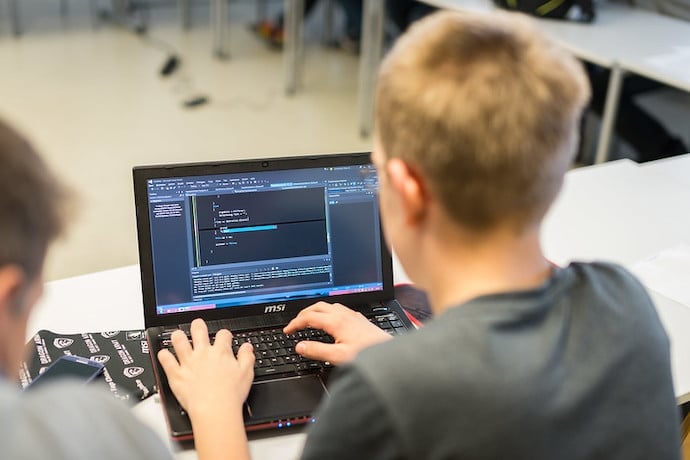In this issue we’ll be covering a small games-writing framework that I’ve quickly become fond of: LÖVE.
LÖVE is a small framework for 2D games closer to something like PyGame than to something like Unity or Gamemaker. On one hand, that means there’s more that you need to code in order to make a game but it also means you have a ton of freedom and get to learn a lot more about what goes into games programming.
LÖVE is built around the language Lua. If you’ve been reading this magazine for awhile you might recognize Lua from past issues, particularly as the language that most fantasy computers—all-in-one retro game making & playing tools such as PICO-8, TIC-80, LIKO-12, or Pixel Vision 8—are built off of.
Lua feels a lot like Python but, in my opinion, is a little simpler and easier to use. One big reason is that it reduces a lot of different ways of dealing with data—lists, arrays, maps, dictionaries, objects, stacks, queues—to just one: the table. I think this means that there’s just less you have to learn and remember in order to feel competent in Lua.
There was a past article on Lua available here and there’s also a lot of excellent documentation on the main Lua Site .
Now, about LÖVE in particular. It has a few important concepts that we should go over. First, every LÖVE game is built around three functions
- love.load()
- love.update(dt)
- love.draw()
love.load runs at the very beginning of the program, so you can load up all the images, music, etc. and define all the variables and setup. love.draw is what it sounds like and is the function that draws everything to the screen once per frame. love.update on the other hand is the only function that takes an argument, which is the amount of time that has passed since the last frame. You need this information in order to make the gameplay and physics consistent no matter how fast or slow the framerate, or the number of times the screen is redrawn per second, ends up being.
Now, since LÖVE has excellent documentation and more than one free online book teaching you how to write games for it, I’m going to jump to a complete example that shows off a feature I really like about LÖVE: the ability to use shader code in your game seamlessly.
If you want a refresher on shader, check out this article from earlier this year but the tl;dr is that you can write special code in the GLSL language in order to harness your graphics card & create visual effects for your game.

Here we’re going to show a complete example of a scene in LÖVE where the player has a light around them, illuminating the scene within a radius.
function love.load()
-- shader code in
effect = love.graphics.newShader [[
extern number playerX;
extern number playerY;
vec4 effect(vec4 color, Image texture, vec2 texture_coords, vec2 pixel_coords)
{
vec4 pixel = Texel(texture, texture_coords ); //This is the current pixel color
number dist = (pixel_coords.x - playerX)*(pixel_coords.x - playerX) + (pixel_coords.y - playerY)*(pixel_coords.y - playerY);
number maxdist = 50000;
if( dist < maxdist) {
pixel.r = pixel.r * (1 - dist / maxdist);
pixel.g = pixel.g * (1 - dist / maxdist);
pixel.b = pixel.b * (1 - dist / maxdist);
return pixel;
}
else {
return vec4(0,0,0,1);
}
}
]]
background = love.graphics.newImage("topwall.png")
player = {x = 300, y = 300}
end
function love.keypressed(key)
if key == "w" then
player.y = player.y - 5
end
if key == "s" then
player.y = player.y + 5
end
if key == "a" then
player.x = player.x - 5
end
if key == "d" then
player.x = player.x + 5
end
end
function love.update(dt)
effect:send("playerX",player.x)
effect:send("playerY",player.y)
end
function love.draw()
--draw background and other objects
love.graphics.setShader(effect)
-- draw background
love.graphics.draw(background,0,0)
-- draw rectangles
love.graphics.setColor(1,1,1,1)
love.graphics.rectangle("fill",50,50,50,50)
love.graphics.rectangle("fill",200,200,50,50)
love.graphics.rectangle("fill",600,50,50,50)
-- end shader
love.graphics.setShader()
-- draw player)
love.graphics.setColor(1,1,1,1)
love.graphics.ellipse("fill",player.x,player.y,40,40)
end
Installing and running LÖVE is pretty simple. The main website has packages you can download and install. Running it can be slightly finicky depending on your operating system, so check the instructions here first!
There are a number of other great features in LÖVE that we didn’t even have a chance to discuss including
-
- built-in bindings to a physics engine if you want to quickly add in realistic collisions, gravity, and acceleration
touchscreen support - a simple camera interface that lets you shift the perspective and scale of what the player sees easily
- tons of libraries that are made to expand and enhance LÖVE all available for free
- built-in bindings to a physics engine if you want to quickly add in realistic collisions, gravity, and acceleration
So if you want to dive into some surprisingly sophisticated-yet-easy games making, try out LÖVE and get hacking!
Learn More
Löve definition
https://love2d.org/wiki/Main_Page
Löve Beginner’s Guide
http://blogs.love2d.org/content/beginners-guide-shaders
How to Löve
https://sheepolution.com/learn/book/contents
Löve game engine
https://en.wikipedia.org/wiki/L%C3%B6ve_(game_engine)
Getting started with Löve
https://ebens.me/post/a-guide-to-getting-started-with-love2d
Getting started with Lua
https://www.lua.org/start.html
Lua programming language
https://en.wikipedia.org/wiki/Lua_(programming_language)
Roblox Coding with Lua
https://codakid.com/hour-of-code/
Top 7 Kids’ Coding languages
https://codakid.com/top-7-kids-coding-languages-of-2018/
Roblox skills
https://thecodewiz.com/how-roblox-coding-teaches-kids-skills-that-grooms-them-for-the-future/

